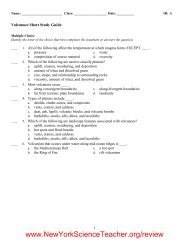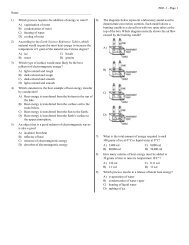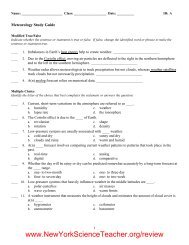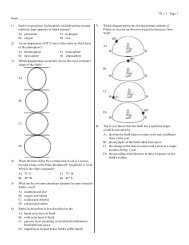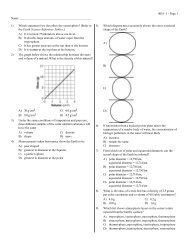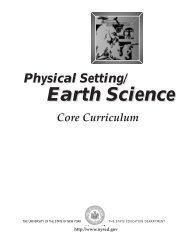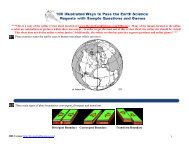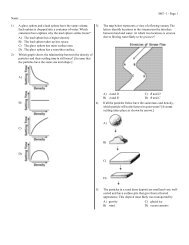temperature changes during 1 year in New York - Earth Science Review
temperature changes during 1 year in New York - Earth Science Review
temperature changes during 1 year in New York - Earth Science Review
Create successful ePaper yourself
Turn your PDF publications into a flip-book with our unique Google optimized e-Paper software.
12) Which graph below best represents the relationship<br />
between the angle of <strong>in</strong>solation and the <strong>in</strong>tensity of<br />
<strong>in</strong>solation?<br />
A)<br />
B)<br />
C)<br />
D)<br />
13) In which diagram does the <strong>in</strong>com<strong>in</strong>g solar radiation reach<strong>in</strong>g<br />
the <strong>Earth</strong>'s surface have the greatest <strong>in</strong>tensity?<br />
A)<br />
B)<br />
C)<br />
D)<br />
14) Dur<strong>in</strong>g which month does the m<strong>in</strong>imum duration of<br />
<strong>in</strong>solation occur <strong>in</strong> <strong>New</strong> <strong>York</strong> State?<br />
A) February<br />
B) December<br />
C) September<br />
D) July<br />
15) Over a period of one <strong>year</strong>, which location would probably<br />
have the greatest average <strong>in</strong>tensity of <strong>in</strong>solation per unit<br />
area? [Assume equal atmospheric transparency at each<br />
location.]<br />
A) <strong>New</strong> <strong>York</strong> City (41D N)<br />
B) Tropic of Cancer (23\D N)<br />
C) the North Pole (90D N)<br />
D) the Arctic Circle (66\D N)<br />
16) In <strong>New</strong> <strong>York</strong> State, the longest period of <strong>in</strong>solation occurs<br />
on or about<br />
A) June 21<br />
B) March 21<br />
C) August 21<br />
D) January 21<br />
17) Which statement best describes how the <strong>in</strong>solation <strong>changes</strong><br />
<strong>in</strong> <strong>New</strong> <strong>York</strong> State from May 21 through June 21?<br />
A) The <strong>in</strong>tensity and the duration of <strong>in</strong>solation both<br />
decrease.<br />
B) The <strong>in</strong>tensity of <strong>in</strong>solation decreases and the duration<br />
of <strong>in</strong>solation <strong>in</strong>creases.<br />
C) The <strong>in</strong>tensity and the duration of <strong>in</strong>solation both<br />
<strong>in</strong>crease.<br />
D) The <strong>in</strong>tensity of <strong>in</strong>solation <strong>in</strong>creases and the duration<br />
of <strong>in</strong>solation decreases.<br />
18) Electromagnetic energy that reaches the <strong>Earth</strong> from the Sun<br />
is called<br />
A) <strong>in</strong>solation<br />
B) conduction<br />
4364 - 1 - Page 2<br />
C) terrestrial radiation<br />
D) specific heat



